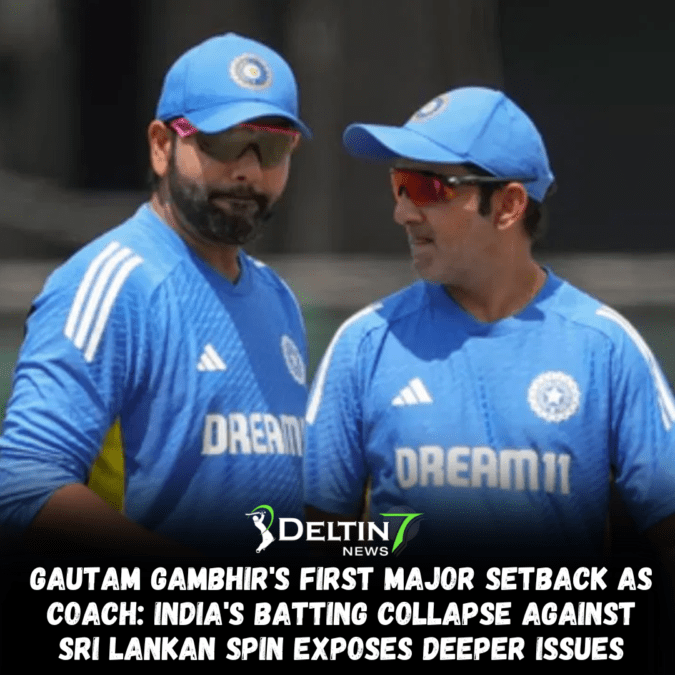
Gautam Gambhir’s First Major Setback as Coach: India’s Batting Collapse Against Sri Lankan Spin Exposes Deeper Issues
In what can only be described as a surprising turn of events, the Indian cricket team, under the guidance of newly appointed coach Gautam Gambhir, suffered a crushing defeat in their second One-Day International (ODI) series against Sri Lanka. The series loss not only dealt a significant blow to Gambhir’s early coaching career but also raised serious questions about the Indian team’s ability to handle quality spin bowling, especially on turning tracks. The comprehensive nature of the defeat—marked by India’s failure to chase down targets and their inability to cope with Sri Lanka’s spinners—has reignited concerns about the team’s standing as one of the premier players of spin in world cricket.
A Disappointing Series and Unfulfilled Expectations
For a team of India’s stature, this defeat was not just unexpected; it was a major shock. The signs of vulnerability had been there in previous matches, but this series loss has brought those weaknesses into sharp focus. India’s batting line-up, traditionally known for its prowess against spin, faltered miserably against Sri Lanka’s spinners, who seemed to relish the challenge of bowling on turning tracks that offered considerable assistance.
Captain Rohit Sharma, known for his candid assessments, did not shy away from acknowledging the team’s shortcomings. In the post-match presentation, he made no excuses for the poor performance, particularly after India lost 27 wickets to spin across the three ODIs. The statistic alone is staggering, but what makes it even more alarming is the manner in which the Indian batters succumbed to the Sri Lankan spinners.
India batted second in each of the three games, on pitches that were slow and increasingly difficult to bat on as the matches progressed. These surfaces were tailor-made for spinners, with the ball gripping and turning sharply. Despite this, India’s response was inadequate. The team seemed bereft of ideas and failed to devise any effective strategy to counter the spin threat posed by the Sri Lankans.
Sri Lanka’s Mastery of Spin: A Lesson in Adaptability
While India floundered, Sri Lanka demonstrated exactly how to approach batting on such difficult surfaces. In each match, their batsmen, particularly the right-handed duo of Avishka Fernando and Kusal Mendis, showcased a masterclass in playing spin. Their use of the sweep and slog-sweep was exemplary, particularly in the final ODI where their second-wicket partnership of 82 runs set the foundation for a competitive total. The Sri Lankan batsmen cleverly targeted the square boundaries, avoiding the more risky straight hits and exploiting the conditions to their advantage.
In stark contrast, the Indian batters seemed trapped by their own hesitations. They neither committed to positive strokeplay nor displayed the courage to take calculated risks. Instead, they found themselves caught in a no-man’s land, unsure whether to attack or defend. This indecision played right into the hands of the Sri Lankan spinners, who bowled with discipline and skill, making full use of the conditions.
Rohit Sharma, in his role as captain and opener, tried to lead by example. He understood the importance of the Powerplay overs, recognizing that runs were easier to come by before the ball became softer and more challenging to score off. However, his aggressive intent did not seem to inspire his teammates. The rest of the batting line-up, including seasoned campaigners like Virat Kohli, failed to follow his lead. Kohli, in particular, was a major disappointment. Known for his ability to tackle spin, he struggled to make an impact and was dismissed cheaply in each of the three games.
The Gambhir Dilemma: Coaching Amidst Chaos
For Gautam Gambhir, an accomplished player of spin during his playing days, watching his team falter in such fashion must have been a frustrating experience. Despite filling the batting order with nine full-time batsmen in the final ODI, India recorded their lowest total of the series, crumbling to 138 all out in under two hours. It was a disheartening display, and for Gambhir, this third collapse in six nights would have been particularly galling.
One of the key issues highlighted by this series was India’s lack of confidence in their footwork against spin. The batsmen were reluctant to leave their crease, preferring to play from the safety of the crease. This cautious approach, however, brought leg-before dismissals into play, especially on pitches where the ball kept low as the match progressed. This defensive mindset was symptomatic of a deeper problem—India’s inability to adapt to challenging conditions.
A particularly illustrative moment came when Rishabh Pant, playing his first ODI since November 2022, decided to step out of his crease to take on Maheesh Theekshana. Pant’s attempt to assert dominance ended in disaster as the ball spun past his outside edge, allowing wicketkeeper Kusal Mendis to effect a swift stumping. Pant’s dismissal was a reflection of the broader issues plaguing the Indian team—an inability to execute their plans with conviction and the lack of a clear strategy to counter the opposition.
The KL Rahul vs Rishabh Pant Debate
Pant’s failure in this series has only intensified the ongoing debate over who should be India’s preferred wicketkeeper-batter in ODIs. KL Rahul, who has performed admirably in this role in recent matches, was the first choice for the opening two games of the series. With India’s next ODI assignment not scheduled until February, the debate is likely to continue, with Rahul seemingly ahead in the race to secure the position leading up to the Champions Trophy in February-March.
Rohit Sharma’s Reflections and the Road Ahead
In the aftermath of the series loss, Rohit Sharma was forthright in acknowledging that Sri Lanka had outplayed India in all departments. He refused to blame individual players or specific aspects of the game, instead choosing to focus on the collective failure. Rohit also hinted at potential changes in personnel as India looks ahead to future series, though he wisely avoided conducting a detailed post-mortem in public, reserving such discussions for the dressing room.
The captain’s level-headed response is indicative of a desire to learn from the defeat and move forward. As India prepares for their next series—a two-Test home assignment against Bangladesh—this 2-0 ODI series loss will likely fade from public memory. However, the lessons learned must not be forgotten. India’s struggles against spin in this series are a reminder that no team, regardless of its past successes, can afford to be complacent.
Conclusion: A Series to Reflect On
The ODI series defeat to Sri Lanka has exposed vulnerabilities in the Indian batting line-up that need to be addressed. For Gautam Gambhir, this early setback as coach offers an opportunity to reassess strategies and work on building a more resilient team. While the loss is disappointing, it also serves as a valuable learning experience that could help India avoid similar pitfalls in the future.
As the team regroups and looks ahead to upcoming challenges, it will be crucial for both players and coaches to reflect on the mistakes made in this series. Adapting to different conditions, especially on spinning tracks, remains a critical aspect of success in international cricket. The Indian team, under Gambhir’s guidance, must now focus on turning this defeat into a stepping stone for future victories.














